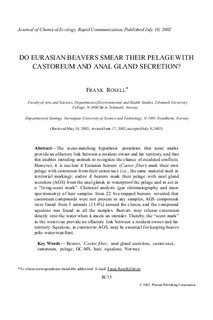Do Eurasian beavers smear their pelage with castoreum and anal gland secretion
Journal article, Peer reviewed
Permanent lenke
http://hdl.handle.net/11250/2438083Utgivelsesdato
2002Metadata
Vis full innførselSamlinger
Originalversjon
Journal of chemical ecology 28(2002), No. 8, p.1697-1701 http://dx.doi.org/10.1023/A:1019954020963Sammendrag
The scent-matching hypothesis postulates that scent marks provide an olfactory link between a resident owner and his territory, and that this enables intruding animals to recognize the chance of escalated conflicts. However, it is unclear if Eurasian beavers (Castor fiber) mark their own pelage with castoreum from their castor sacs (i.e., the same material used in territorial marking); and/or if beavers mark their pelage with anal gland secretion (AGS) from the anal glands to waterproof the pelage and to act as a ldquoliving-scent mark.rdquo Chemical analysis (gas chromatography and mass spectrometry) of hair samples from 22 live-trapped beavers revealed that castoreum compounds were not present in any samples, AGS compounds were found from 3 animals (13.6%) around the cloaca, and the compound squalene was found in all the samples. Beavers may release castoreum directly into the water when it meets an intruder. Thereby, the "scent mark" in the water can provide an olfactory link between a resident owner and his territory. Squalene, in contrast to AGS, may be essential for keeping beaver pelts water-repellant.
Beskrivelse
The original publication is available at www.springerlink.com
